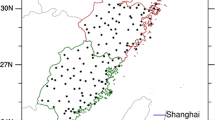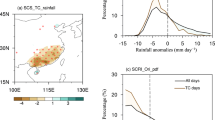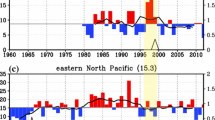Abstract
This study concerns the precipitation induced by a tropical cyclone (TC) before the TC arrives, which will be referred to as TC remote precipitation (TRP). Based on the distribution characteristics of the non-rotational wind and the divergent-wind vertical circulation related to TC, the subtropical high, and TRP of 45 TRP events during June, July, and August of 2000‒2009, the relationships among these three entities (TC, subtropical high, and TRP) can be categorized into four patterns. The first pattern accounts for the highest proportion of the TRP events (59%), and a conceptual model is then provided for this pattern. The primary characteristics of this model are as follows: TC, the subtropical high, and TRP can interact with each other through the divergent-wind secondary circulation at both sides of the ridge line of the subtropical high (between the subtropical high and TC, and between the subtropical high and TRP). At the upper level (150 or 200 hPa), the northward non-rotational wind from the TC converged toward the subtropical high ridge line and subsided, and at 950 hPa the divergent wind from the ridge line of the subtropical high converged toward TC; these constructed the secondary circulation between TC and the subtropical high. In the meantime, the southward nonrotational wind at the upper level (150 or 200 hPa) from TRP and the divergent wind at 950 hPa from the subtropical high ridge line toward TRP constructed the secondary circulation between TRP and the subtropical high. As TC and TRP interacted with each other, the subtropical high ridge line was usually under the downdraft area of the whole atmosphere. The other three patterns are different from the first pattern mainly in terms of the intensity and position of the non-rotational-wind secondary circulation. The numerical simulation of the Beijing 7•21 rainstorm confirmed the relationship among TC, the subtropical high, and TRP, indicating that when the interaction weakened, the TRP also weakened.
Similar content being viewed by others
References
Bosart L F, Carr F H (1978). A case study of excessive rainfall centered around Wellsville, New York, 20-21 June 1972. Mon Weather Rev, 3 (106): 348–362
Bosart L F, Cordeira J M, Galarneau T J, Moore B J, Archambault H M (2012). An analysis of multiple predecessor rain events ahead of tropical cyclones Ike and Lowell: 10–15 September 2008. Mon Weather Rev, 4(140): 1081–1107
Byun K Y, Lee T Y (2012). Remote effects of tropical cyclones on heavy rainfall over the Korean peninsula–Statistical and composite analysis. Tellus A, 64, 14983, doi: 10.3402/tellusa.v64i0.14983.
Chen L S (2007). Study and prediction of heavy rainfall associated with landfalling tropical cyclones. In: Proceedings of the 14th National Symposium on Tropical Cyclone, 3–7 (in Chinese)
Chen L S, Li Y (2004). An overview on the study of the tropical cyclone rainfall. Proc. Inter. Conf. on Storms, Brisbane, Australian Meteorological and Oceanographic Society, 112–113
Cong C H (2011). Study on tropical cyclone remote rainfall. Doctor dissertation, 151–152 (in Chinese)
Cong C H, Chen L S, Lei X T, Li Y (2012). Study on tropical cyclone remote rainfall. Acta Meteorol Sin, 70(4): 717–727 (in Chinese)
Cote M R (2007). Predecessor rain events in advance of tropical cyclones. M.S. thesis, Department of Atmospheric and Environmental Sciences, University at Albany, State University of New York, 200
Ding Z Y, Zhao X H, Xing R, Gao S (2014). Statistical analysis of summer tropical cyclone remote precipitation events in East Asia from 2000 to 2009 and numerical simulation. Journal of Tropical Meteorology, 30(2): 229–238 (in Chinese)
Galarneau T J, Bosart L F, Schumacher R S (2010). Predecessor rain events ahead of tropical cyclones. Mon Weather Rev, 8(138): 3272–3297
Hanley D, Molinari J, Keyser D (2001). A composite study of the interactions between tropical cyclones and Upper-Tropospheric Troughs. Mon Weather Rev, 129(10): 2570–2584
Kawamura R, Ogasawara T (2006). On the role of typhoons in generating PJ teleconnection patterns over the Western North Pacific in late summer. SOLA, 2: 37–40
Li C H, Huang F J, Luo Z X (2002). The influence of typhoon on subtropical high location and intensity. Plateau Meteorology, 21(6): 576–582 (in Chinese)
Moore B J, Bosart L F, Keyser D, Jurewicz M L (2013). Synoptic-scale environments of predecessor rain events occurring east of the Rocky Mountains in association with Atlantic Basin tropical cyclones. Mon Weather Rev, 141(3): 1022–1047
Murata A (2009). A mechanism for heavy precipitation over the Kii Peninsula accompanying typhoon Meari. Journal of the Meteorological Society of Japan, 87(1): 101–117
Schumacher R S, Galarneau T J (2012). Moisture transport into midlatitudes ahead of recurving tropical cyclones and its relevance in two predecessor rain events. Mon Weather Rev, 140(6): 1810–1827
Schumacher R S, Galarneau T J, Bosart L F (2011). Distant effects of a recurving tropical cyclone on rainfall in a midlatitude convective system: a high-impact predecessor rain event. MonWeather Rev, 139 (2): 650–667
Wang Y Q, Fudeyasu H (2009). The role of typhoon Songda (2004) in producing distantly located heavy rainfall in Japan. Mon Weather Rev, 137(11): 3699–3716
Author information
Authors and Affiliations
Corresponding author
Rights and permissions
About this article
Cite this article
Xing, R., Ding, Z., You, S. et al. Relationship of tropical-cyclone-induced remote precipitation with tropical cyclones and the subtropical high. Front. Earth Sci. 10, 595–606 (2016). https://doi.org/10.1007/s11707-015-0530-7
Received:
Accepted:
Published:
Issue Date:
DOI: https://doi.org/10.1007/s11707-015-0530-7




